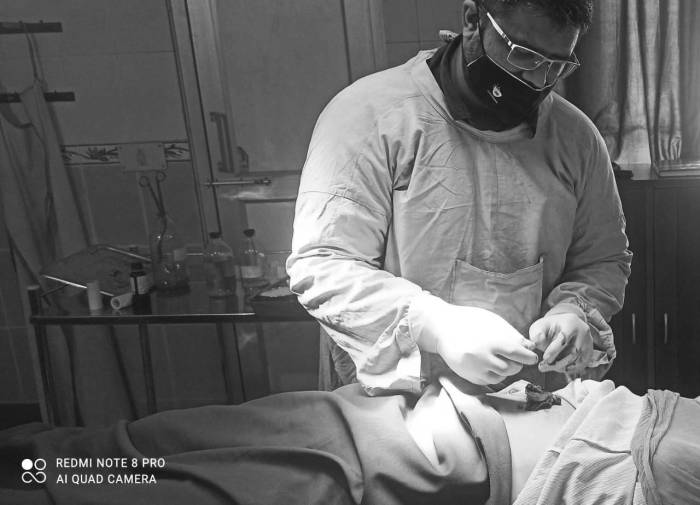
GANGRENE
know about gangrene
Gangrene happens when a lack of oxygen-rich blood causes tissue to die in some part of the body, often the hands or feet.
It is a serious condition that can result in amputation of a limb or death. It needs urgent treatment of tissue death as rapidly as possible.
Diabetes is linked to gangrene. Diabetic neuropathy, or nerve death, can mean that a person has an injury and does not notice it.
Diabetes also affects the small arterial vessels and they become insufficient to supply the extremity. Other risk factors are smoking and conditions such as Raynaud’s disease.
Fast facts on gangrene
Here are some key points about gangrene. More detail is in the body of this article.
- Gangrene occurs when a lack of blood supply, and therefore oxygen, results in tissue death.
- Gangrene is usually external, affecting the extremities, but it can also affect internal tissues.
- Surgical complications can lead to internal gangrene, with signs of toxic shock.
- Urgent treatment is important to prevent further serious illness and death. This includes removal of dead tissue and sometimes amputation.
Gangrene refers to the death and rotting of skin tissue and skin cells.
The two main forms of gangrene are known as dry and wet gangrene.
Other types, such as Fournier’s gangrene and internal gangrene, are less common.
Dry gangrene
Dry gangrene is sometimes called mummification. It starts more slowly than wet gangrene, and it is most commonly associated with chronic disease, including diabetes.
The skin becomes dry, shriveled, and usually dark in color, ranging from brown to purplish-blue and feels cool or cold to touch.
Blood vessel diseases such as atherosclerosis commonly cause dry gangrene.
Wet gangrene
In wet or moist gangrene, the skin swells and blisters form and may rupture. Pus may appear.
It is generally associated with infection of the dead tissue. Wet gangrene can develop following a severe burn or frostbite.
This type of gangrene can occur in people with diabetes who have an injury but do not notice or attend to it due to diabetic neuropathy.
Wet gangrene needs immediate treatment, as it can spread quickly and be fatal.
Gas gangrene, also called clostridial myonecrosis, is a particularly virulent form of wet gangrene.
It is associated with poorly cleansed wounds. It sometimes results from surgery in which the blood supply has become damaged.
Dry forms result from a progressive loss of blood supply to tissues. Dry forms can become wet forms if they develop a bacterial infection.

Deep or crushing injuries sustained in bacteria-rich conditions, such as a battlefield, can lead to gangrene.
All forms of gangrene happen because of a loss of blood supply to a certain area. This deprives tissue of oxygen and nutrients, causing the tissue to die.
Dry forms can also result from:
- Vascular problems: Most commonly due to the poor health of arteries and veins in the legs and toes. This usually develops over time due to conditions such as diabetes, peripheral arterial disease, and high blood pressure.
- Severe burns, scalds, and cold: Heat, chemical agents, and extreme cold, including frostbite, can all lead to dry gangrene. Wet gangrene may develop later.
- Raynaud’s disease: There is impaired circulation to the ends of fingers and toes, especially in cold weather. Raynaud’s is implicated in some cases of gangrene.
- Diabetes: Imbalanced blood sugar levels can damage blood vessels and nerves, reducing the oxygen supply to extremities.
Wet forms can develop from:
- Injury: Deep, crushing, or penetrating wounds that are sustained in conditions that allow bacterial infection can lead to gangrene. Examples are war zones and railway, machinery, and street accidents, if lacerated and bruised tissues are contaminated.
- Dry gangrene: If the area is infected with bacteria.
- Embolism: The sudden blockage of an artery can lead to dry gangrene, but it also increases the risk of infection, and therefore wet gangrene.
- Immune deficiency: If an immune system is weakened, for example by HIV, diabetes, long-time alcohol or drug abuse, or recent chemotherapy or radiotherapy, minor infections escalate more quickly and can become gangrenous.
Risk factors for gangrene include:
- smoking
- obesity, diabetes, high blood pressure, and other causes of vascular disease
- excessive alcohol intake, which can lead to nerve damage
- impaired immune function, due for example, to HIV infection, chemotherapy, and radiation therapy
- intravenous drug use
Rarely, gangrene is linked to use of the anticoagulant drug, warfarin.
The major features of wet or dry gangrene are:
- Loss of color in the affected body part: The area will become discolored and eventually turn dry and dark. The color will change from red to black in dry gangrene, or it will become swollen and foul-smelling in wet gangrene. Gas gangrene will produce particularly foul-smelling, brownish pus.
- Shiny appearance to the skin and the shedding of skin, with a clear line forming between affected and healthy skin.
- Pain that is later followed by loss of sensation and an inability to move the part.
The part will be cold to the touch, and there will be a loss of pulse in the arteries.
Internal gangrene
Gangrene of the internal organs is slightly different but also involves tissue death.
There may not be any external signs of internal gangrene, but the following may occur as a result of septic shock and other complications:
- fever and chills
- confusion
- nausea, vomiting, and diarrhea
- low blood pressure leading to light-headedness and fainting
- shortness of breath and increased heart rate
Gas gangrene
Gas gangrene can produce all of these symptoms, and others. The infected area of skin can quickly extend, with some changes visible within minutes.
In gas gangrene, the skin may:
- be very painfully swollen
- be pale at first, but become red or bronze before finally turning blackish-green
- show blisters filled with brown-red fluid
- produce a foul-smelling brown-red or bloody fluid when the affected tissue is drained or leaks, known as a serosanguineous discharge
- create a crackling sensation, or crepitus, on examination, due to the movement of gas under the skin
This is known as subcutaneous emphysema. The gas is produced by the infectious bacteria and is highly toxic, causing the necrosis to spread quickly.
Gas gangrene is very serious and immediately life threatening.



